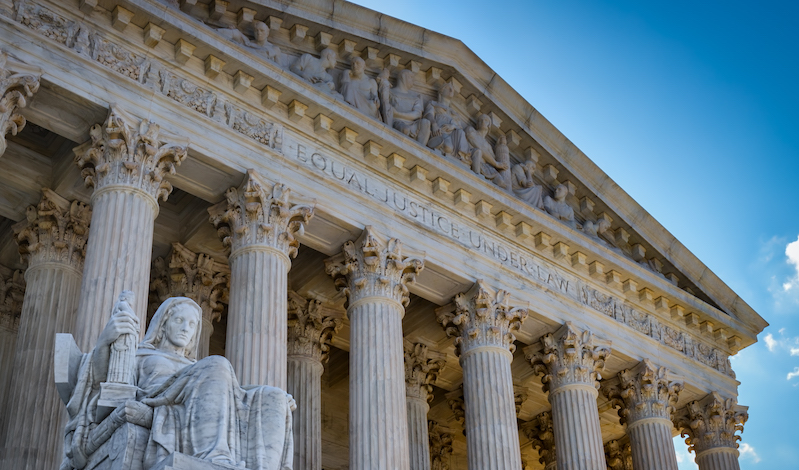
One of the Supreme Court’s most significant administrative law precedents may soon be overturned.
At the same time that the U.S. Supreme Court seems poised to overturn its nearly fifty-year-old precedent on abortion rights, it may also be ready this month to overturn or retreat from another of its longstanding precedents: Chevron v. Natural Resources Defense Council.
Although far less known than Roe v. Wade, the Court’s Chevron decision has for almost forty years governed the relationship between Congress, regulatory agencies, and the courts. It has come to be one of the most widely cited decisions by lower courts in the Supreme Court’s history—certainly more than Roe.
Yet, despite Chevron’s longstanding acceptance, a conservative majority on the Court appears ready to repudiate Chevron. In several cases likely to be handed down soon, including American Hospital Association v. Becerra and West Virginia v. U.S. Environmental Protection Agency, the Court has before it questions over which Chevron’s fate could be sealed.
If the Court overturns or abandons Chevron, the postmortems will commence, asking what doomed Chevron. The most immediate answer to come to mind will be the recently changed composition of the Court. After all, two of the newest members of the Court—Justices Neil Gorsuch and Brett Kavanaugh—criticized Chevron as lower court judges.
But beyond the politics of the Court, lawyers and scholars may have themselves unintentionally played a role in its demise in recent decades by deploying the language of what has come to be known as “Chevron Step Zero.”
Chevron emerged in 1984 out of a dispute between environmental groups and the Reagan Administration over a market-style regulation adopted by the U.S. Environmental Protection Agency (EPA). Although environmentalists had argued that EPA’s policy conflicted with the Clean Air Act, the Court upheld the policy, concluding that it needed to give deference to the agency’s interpretation of the Clean Air Act.
In deciding the case, the Court articulated a two-step process that has come to be known by lawyers as the Chevron doctrine or framework: Judges should ask whether the statute at issue is clear and apply it if it is (Step One); but if it is not clear, then judges are to defer to the agency’s interpretation of the statute, provided the agency’s interpretation is reasonable (Step Two).
A unanimous decision of eight justices, Chevron raised no conservative eyebrows at the time it was handed down. For many years, even the late Justice Antonin Scalia ranked among its supporters on the bench. And yet today, antipathy to Chevron is strongest among justices appointed by Republican presidents.
Craig Green at Temple University’s law school has argued that conservatives’ antipathy toward Chevron seemed to emerge around the time President Barack Obama entered the White House. Coincidence? From the perspective of politics, deference to agencies surely holds differing levels of appeal depending on which political party occupies the White House and oversees the executive branch.
Yet another set of possible factors undermining Chevron might derive from how the doctrine has evolved over the years. Judges and scholars found confusing, for example, the Court’s 2001 decision in United States v. Mead. The Court in Mead held that Chevron deference is limited to instances where the agency had exercised its authority to make binding law, such as when an agency articulated its interpretation of a statute in a rulemaking, just as EPA had done in Chevron
Following Mead, scholars started to write and teach that Chevron no longer had just two steps; it had three. That was sensible, as Mead did articulate three requirements to be met before a court needs to defer to an agency. Not only did the statute need to be ambiguous and the agency’s interpretation reasonable, but now the agency’s interpretation also needed to derive from the agency’s authority to make binding law.
Legal scholars, lawyers, and judges came to treat this third requirement as an initial step in a logical progression. Instead of seeing it as an add-on to Chevron’s second step—or even as a step just prior to Step Two—the new initial step came, in creative fashion, to be known as Chevron Step Zero.
In addition to the third requirement articulated in Mead, Step Zero came to encompass other elements. The Supreme Court, for example, has articulated a so-called major-questions test that precludes deference in disputes over statutory meaning that hold “deep ‘economic and political significance.’” Cass Sunstein has written that this test presents “a separate Step Zero question by suggesting the possibility that deference will be reduced, or even nonexistent, if a fundamental issue is involved.”
But by inserting a step prior to Step One, might lawyers and scholars have unintentionally helped contribute to Chevron’s demise? To be sure, Step Zero has not expressly figured into contemporary critiques of Chevron. But then again, Step Zero hardly allays concerns that Chevron implicitly encourages judges to abdicate their responsibilities to apply the law—a common criticism leveled by Chevron’s critics.
After all, Step One lays out a foundational rule-of-law test: If a statute is clear, a judge must apply that clear meaning and the agency must follow it. As the Chevron Court explained, at this first step, “if the intent of Congress is clear, that is the end of the matter; for the court, as well as the agency, must give effect to the unambiguously expressed intent of Congress.”
If some other step precedes Step One, and if each step must be cleared to reach the next, then the existence of a Step Zero logically means that in some cases a judge might never reach Step One—and therefore would presumably never need to treat the clear meaning of a statute as “the end of the matter”!
No doubt that was never the intention behind Step Zero. Nor was another way that Step Zero may have added to critics’ concerns that Chevron leads to judicial abdication. Critics of Chevron worry that it encourages judges almost automatically to defer to agencies’ legal positions, rather than conducting their own independent judicial analysis. They point to the Administrative Procedure Act’s requirement that only the “court shall decide all relevant questions of law”—not the agency.
How does Step Zero tacitly, even if unintentionally, accept this critique? It does so by treating the entire Chevron doctrine or framework as equivalent to Chevron deference. An opinion issued by the U.S. Court of Appeals for the Ninth Circuit, for example, has noted that “at Chevron step zero, we ask whether the Chevron framework applies at all.”
The Chevron framework, though, entails two steps—or, after Mead, several requirements—each of which presents “relevant questions of law” for judges to decide. By contrast, deference is only what occurs at the end of Step Two. Chevron made deference the end point reached after a sequential process of judicial analysis and interpretation.
By inserting a step before this sequential process, and then lumping together all the parts of the process with the outcome that the process sometimes yields, Step Zero seems almost to accept that the entire Chevron framework is risky. It suggests that the framework overall needs to be avoided, at least at times, because it seems too easily or automatically to lead judges toward “overdoing deference,” to borrow a phrase from Michael Herz at the Cardozo School of Law.
I have elsewhere explained why the more faithful reading of Chevron would have been to acknowledge steps between Step One and Step Two—not to insert a step before Step One. Seeing Chevron as a staircase with interstitial steps also would have better shown how much judges do still bear full responsibility for deciding all the “relevant questions of law.”
Such an approach also basically aligns with what the Court recently adopted in a related case—Kisor v. Wilkie—with respect to agencies’ interpretations not of statutes (as with Chevron) but of their own regulations. In the weeks leading up to the Kisor decision in 2019, speculation abounded that the Court might overturn its earlier decision in Auer v. Robbins, a case with clear parallels to Chevron. That the Court in Kisor did not overturn Auer but instead clarified its structure has given some observers reason to think that, in the end, the Court might not overturn Chevron.
But if Chevron does see its demise—whether by being overturned with fanfare this month or perhaps simply through silent abandonment in the coming years—scholars will undoubtedly ask what doomed the case. Multiple possible explanations will be explored. Politics will be among them, but perhaps so too should be the way Chevron may have been undermined by scholars themselves.




